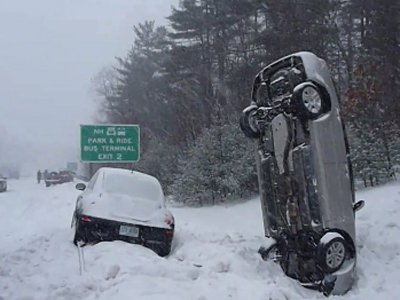As a young new driver, it can be tempting to only think about spinning the wheels of steel and getting out on the road with your buddies and chums as soon as you have passed your test but it is worth considering being prepared in the car, for winter, when it finally comes around.
My first real memory of how snow and ice can affect a car goes way back to when I was only 18. My friend and hairdresser owned a golden brown Capri. (Ask your parents about this car kids.) Alas, the heating didn’t work and on the Saturday night we decided to go clubbing at Tots Discotheque – which of course is now known as Talk Night Club, there was heavy snowfall in the town of Southend on Sea. Where I live.
The first challenge we had was to prepare the car for driving at 2.30 in the morning.
Now, unfortunately- the fact that there was no heating brought about our first challenge. Tracy had no heat to warm us up with, once we had finished clearing the snow off the roof of the car. When you’re at home, you can go out all wrapped up and turn the car on. With the heater working to clear the windscreen and warm the car up and you working with trusty de-icer or scraper to hand, on normal occasions, you are ready to go in a few minutes. We didn’t have any of this – only winter mittens!
On this occasion, wearing a pair of 4-inch stilettos and a very thin dress. Not being prepared, knowing that bad weather is on the way is not necessarily the wisest thing to do.
Tracy had a really long coat, she knew her heater didn’t work but I hadn’t been given that information, so already I was very cold as we attempted to drive away.
The car was a bit sticky on starting and so we needed a bump start. Luckily there were a few willing fellas around to help us out. If it had been left to us, it may have been a different matter due to our choice of attire. When we arrived at the road where I lived, the snow was heavy underneath but below the powdery topping, the ice had formed in the cold. On attempting to turn right and enter my road, her car slid straight past-sideways. We laughed our heads off and finally after going round the block again, she very wisely slowed her speed right down to enable the car to hold its traction.
Although this was all really funny and made a great end to a good evening out. It all could have gone horribly wrong. So when I saw this advice in Southend Councils, Winter edition of Outlook magazine. I thought it was well worth a share.
What To Keep in a Winter Emergency Kit:
- Blanket, rug or sleeping bag
- Shovel
- Bits of carpet or thick cardboard to place under driven wheels to help regain traction on ice or snow
- Salt, sand or cat litter – to help clear snow or ice
- Reflective jacket(s)
- Ice scraper and de-icer
- Torch and batteries
- Tow rope
- Snow chains (if you live in a remote or rural area)
- Battery jump leads
- Bottled water
- Snacks, chocolate or cereal bar
- Extra Screenwash
“motorists are urged to drive with caution and according to road conditions, slowing down where necessary and keeping a safe distance from vehicle in front. Snow tyres are advised in prolonged snow or icy weather, along with smooth braking.”
Karen Grant , Southend on Sea Borough Council’s Team Leader for Environmental care said: “Grit does not prevent snow or ice from forming so highway users still need to be aware of the conditions when they are out and about in bad weather.”
Driving in snow and ice
Gentle manoeuvres are the key to safe driving – stopping distances are 10 times longer in ice and snow.
- Wear comfortable, dry shoes for driving. Cumbersome, snow-covered boots will slip on the pedals.
- Pull away in second gear, easing your foot off the clutch gently to avoid wheel-spin.
- Up hill – avoid having to stop part way up by waiting until it is clear of other cars or by leaving plenty of room to the car in front. Keep a constant speed, choosing the most suitable gear well in advance to avoid having to change down on the hill.
- Down hill – reduce your speed before the hill, use a low gear and try to avoid using the brakes. Leave as much room as possible between you and the car in front.
- If you have to use brakes then apply them gently. Release the brakes and de-clutch if the car skids.
- Automatic transmission – under normal driving conditions (motorways, etc) it’s best to select ‘Drive’ and let the gearbox do the work throughout the full gear range. In slippery, snowy conditions it’s best to select ‘2’, which limits the gear changes and also makes you less reliant on the brakes. Some autos have a ‘Winter’ mode which locks out first gear to reduce the risk of wheel spin. Check the handbook.
If you get stuck, straighten the steering and clear the snow from the wheels. Put a sack or old rug in front of the driving wheels to give the tyres some grip. Once on the move again, try not to stop until you reach firmer ground. theaa.com
So remember, as much as it is tempting when you are going out late in the evening, to not even think about how you may be affected if bad weather moves in quickly. It is well worth, tucking these few things in the boot of your car so you can be prepared.


